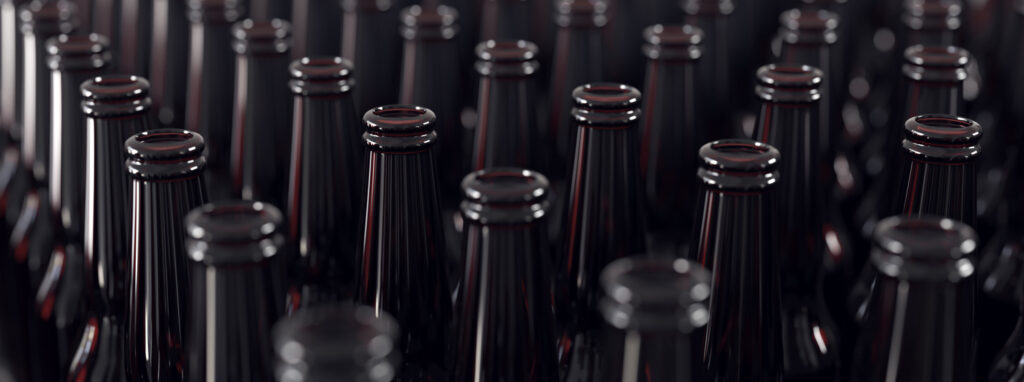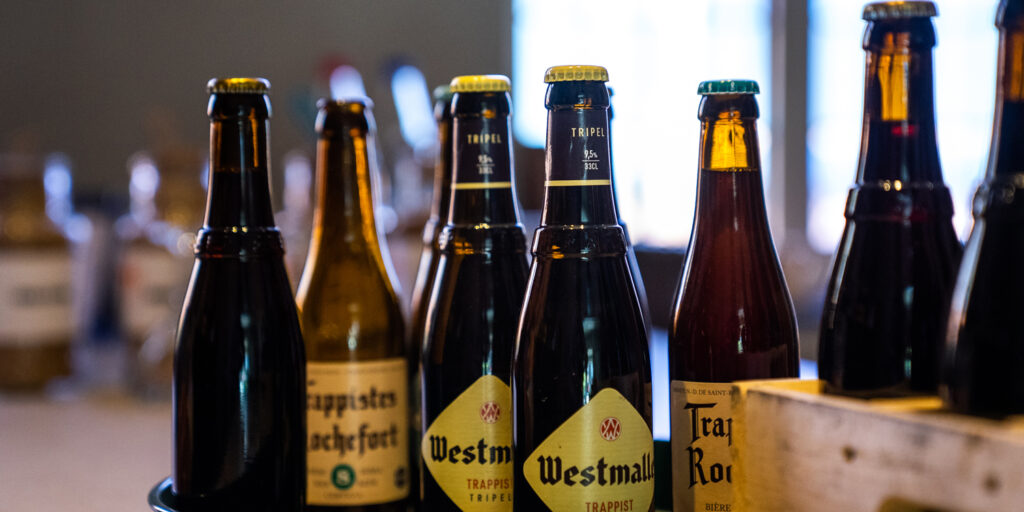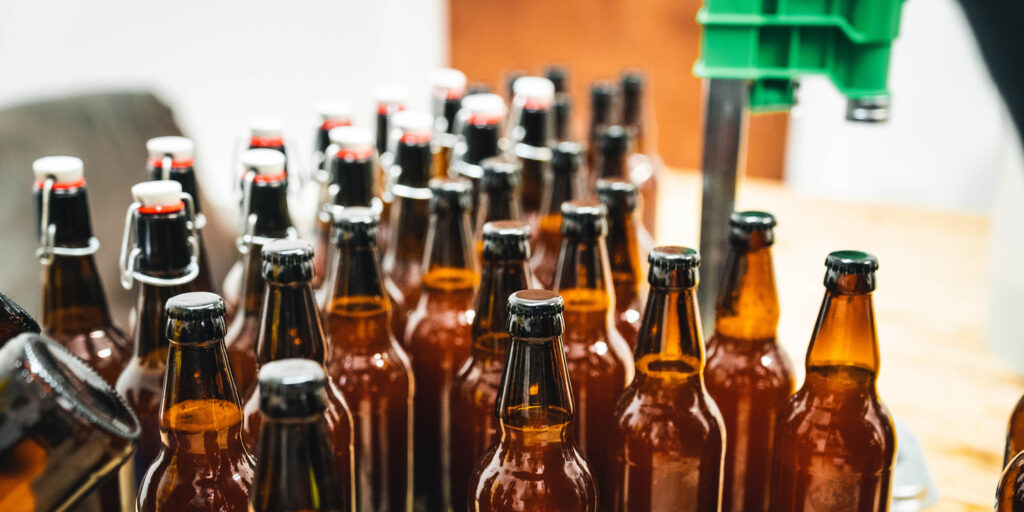Canned Heat — Are Glass Bottles Overdue A Comeback?

When Colorado’s Oskar Blues Brewery first canned its flagship, Dale’s Pale Ale, back in November 2002, it marked the start of a sea change in how modern beer was packaged.
Sticking beer in cans wasn’t exactly a new or, indeed, a particularly revolutionary idea. Records show that beer packaged in cans has existed since 1935, with the Felinfoel Brewery in Wales reportedly being the first to do so in the UK. Although these weren’t the same cans we know today – for starters, the modern, non-detachable ring pulls weren’t introduced until 1990. They were also a slightly different shape to the ones now used by breweries and didn’t have the same technologies such as the acrylic-based lining that prevents beer from having a metallic taint.
What marked Oskar Blues’ foray into canning as significant was that they did so when public opinion of canned beer was pretty low. It simply wasn’t held in the same regard as bottled or draught beer. If you wanted to can, the minimum orders from companies that make them, such as Ball or Crown, were staggering in size. Canning lines were also hideously expensive – not to mention occupied a huge physical footprint – and were only feasibly available to some of the world’s largest beverage producers like Budweiser or Coca-Cola. Oskar Blues were essentially guinea pigs. They may have hoped they’d grow in popularity but probably had no idea that cans would eventually become the de facto packaging method for small breweries.
The industry didn’t make the pivot to cans overnight. Even a decade after Oskar Blues had chosen this lighter, arguably more efficient packaging system, there was plenty of stigma surrounding cans. Good beer, surely, comes packaged in a glass bottle. Even today, you’ll encounter those who’ve been drinking beer long enough to associate canned beer with a signature metallic taint (an off-flavour that is thankfully no longer an issue in most canned beer.)
When the influence of North American craft beer began to wash ashore in the UK and Ireland in the early 2010s, bottles were still the go-to packaging method. I fondly remember smuggling bombers – 22-ounce (650ml) bottles, perfect for sharing – back in my suitcase after trips to the United States. When breweries started using cans, however, it was something of a revelation. I was able to fit almost twice as much beer in my suitcase. With every trip back, more and more breweries were making the switch to cans and I would struggle to bring back all the beer I wanted to.
It also gave breweries the opportunity to play with a larger space for their artwork, helping brands stand out on the shelf. This was another crucial development. The number of breweries was growing rapidly in the 2010s, particularly in the US and the UK, and as the technology gradually became more affordable and newer systems were small enough to fit beneath a railway arch, so too did this new wave of breweries embrace canning.
In the UK, the format was initially adopted by some early ‘trailblazers’ – Camden Town, Beavertown, Fourpure – breweries that had enough financial backing behind them to afford some of the first compact canning lines to hit the market. As a point of differentiation from mass-produced beer, they opted for the smaller 330ml format, more typically associated with soft drinks. Coincidentally, it was also a format that the younger, new wave of beer drinkers who were captivated by both modern American beer culture and the burgeoning developments then happening in the UK were happy to lap up.
Pretty soon, having a canning line went from an indulgent luxury to a necessity for a small brewery. Cans were lighter, easier to ship, stayed colder for longer, and independent bottle shops loved them because customers passing by would typically purchase more because they could carry more home.
Back in the US, the popularity of canning had exploded (sometimes literally, but that’s another story). By 2015, a new wave of breweries, largely based in the northeastern states of New England, were capitalising on the new craze of hazy, very hoppy beer. Breweries such as Treehouse, Trillium and Other Half had switched out from the smaller 12-ounce (355ml) cans to a slightly larger 16-ounce (450ml) format. New beers would often be exclusively packaged in cans and sold in four packs, available directly from the brewery only.

This was a marketing masterstroke. Not only were these breweries driving massive amounts of footfall and selling beer at high margins directly to their customers, but the larger format meant that they were selling more beer to each customer per sale. This idea was soon adopted in the UK, with Cloudwater in Manchester being the first UK brewery to have its machine switched from the 330ml to 440ml format. Previously, like most breweries in the UK, Cloudwater had been bottling its beer, but in 2015 the great switch to cans had begun in earnest. There were now even mobile canning companies, who could be booked into package batches should a brewery not have the resources to secure its own canning line.
Some breweries were initially reluctant to change formats, but the way sales of canned beer were growing, most gave in to the inevitability of it. Thornbridge Brewery in Derbyshire is one example of a brewery that both embraced cans, but has forever stuck by the reliability of glass bottles.
“I think for us being in both can and bottle gives us real flexibility,” the brewery’s head brewer, Rob Lovatt, tells me.
While the switch from bottles to cans has been the dominant story for smaller breweries over the past couple of decades, I’ve noticed the signs of change in the air. The pandemic and the resulting inflation-driven cost of living crisis has changed consumer habits, and businesses are reacting to this. Although I don’t think we’ll see breweries stop using cans any time soon, I strongly feel that market conditions – the aforementioned notwithstanding – will see several breweries reconsider the use of glass in the medium to long term.
“One of the big reasons I love glass bottles is that they can hold more pressure for bottle conditioning,” Lovatt says. “All of our recent 500ml range has been bottle conditioned. I feel bottle conditioning has been overlooked for many years, [and] the benefits that bottle conditioning can bring to certain beers shouldn’t be overestimated.”
Cans are certainly convenient, and the lighter weight of aluminium (plus the fact it’s an easily recyclable material) gives it a lower carbon footprint than glass. You only have to imagine a few hundred thousand empty glass bottles being shipped by road, rail, air and sea to understand how glass has a larger environmental impact than cans.
There are some distinct advantages to bottles, however, and their ability to hold higher levels of pressure is among them. Bottle conditioning allows breweries like Thornbridge to naturally re-ferment their beers in bottles, producing beer with a typically softer, more palatable carbonation. There’s also the added benefit of any remaining yeast in suspension gobbling up extraneous oxygen, meaning the beer has a longer shelf life. Smaller breweries such as Runaway in Manchester and London’s The Kernel have stuck by bottles for the entirety of their existence for these reasons.
Some breweries, such as Moor in Bristol and Sierra Nevada in the US, have adopted technologies that allow them to naturally condition their beer in cans. Most breweries have shied away from this, however, because cans cannot handle the same levels of pressure as bottles. If you’ve ever seen an overprimed can pop its top, you’ll understand what I mean. Largely, however, this hasn’t been widely adopted because of the time and costs involved rather than the fallibility of aluminium.
Another brewery that’s always been in both can and bottle is London’s The Five Points. The brewery actually sold its canning line in early 2020 (a decision that, retrospectively, head brewer Greg Hobbs admits was made at the worst possible time) but still contract cans it’s XPA and has been committed to the use of glass since the brewery was founded in 2013.

“Over the last few years, the craft can category has exploded with more choice than ever before available in the national retailers, making it a very crowded market for breweries to compete in,” Hobbs tells me, adding that The Five Points is mostly set up to produce beer in cask or keg for the on trade.
“We are continuing to develop a range of bottle-packaged beers with some new releases planned in 2024,” he says. “Despite the prevalence of quality canned beer over the last few years, certain pockets of the market still view bottled beer as a premium product, particularly in the restaurants and high-end bars.”
There are also other, more serious reasons why breweries may look towards switching to glass bottles or at least adopting them in part. Although initial efforts to launch a Deposit Return Scheme (where customers take empty bottles back to collection points in exchange for a small amount of money) failed, it is more than likely DRS will be introduced UK-wide at some point in the next few years.
It is also likely that this will initially only include glass, whereas aluminium will continue to be collected from people’s homes. Schemes that involve returning glass bottles are common across Europe – if you’ve ever picked up a bottle of beer while visiting Germany, you might have noticed the lines that form on reused bottles as labels have been repeatedly scrubbed off. As the beer industry becomes increasingly climate-conscious, reusing bottles seems like a sensible option to get one’s carbon footprint down. It will take years of planning and trials before we probably see this in the UK, but its eventual arrival is pretty much inevitable.
Then there are financial factors, like some customers, such as hotels, restaurants or supermarkets, that may request glass bottles specifically. Then there are us drinkers, who are often motivated to purchase things based on current marketing trends. I will admit to really enjoying a nice, cold 330ml bottle of lager at home, and smaller breweries such as Pillars in London and Braybrooke in Leicestershire are happily feeding that habit.
In all likelihood, we’ll never see the back of cans now they’re so established. What was seen as an outsider 20 years ago is now a mainstay of the modern beer industry. But those of us who decided to write off bottles wholesale may end up eating their words. The beer industry is largely driven by trends, and those trends are driven by what people are spending their money on.
As mentioned by Greg Hobbs at the Five Points, some breweries will opt for bottles just to stand out in the saturated can market. If this and other factors dictate that people start buying more beer in bottles, then more breweries will start moving back towards this packaging format themselves. My feeling is that bottles will start a slow but inevitable comeback over the next year or two as the beer industry constantly strives to differentiate itself in a crowded industry.
— Matthew Curtis
Needing Glass Bottles for your brewery? Get them from Geterbrewed: MICROBREWERY GLASS BOTTLES
Homebrew Quantities are also available: HOMEBREW GLASS BOTTLES